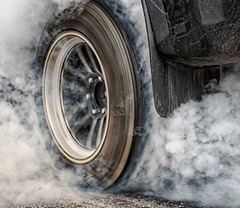 Cars have been synonymous with pollution for several decades, but for fishermen “tire pollution” may be their worst legacy yet …
Cars have been synonymous with pollution for several decades, but for fishermen “tire pollution” may be their worst legacy yet …
Scientists are attributing rubber dust from tire wear as being toxic to Salmon and Steelhead – and when transported into the watershed via rain and runoff, have attributed it to a series of fish kills in Puget Sound and possibly elsewhere.
Treating the runoff to neutralize the chemical would be prohibitively expensive due to the magnitude of paved roads near waterways, so the solution will require a change to tire composition, akin to the replacement of Freon for refrigeration systems.
The chemical is added to rubber to stabilize it from Ozone oxidation and goes by the trade name “6PPD.”
“It’s like a preservative for tires,” Tian said. “Similar to how food preservatives keep food from spoiling too quickly, 6PPD helps tires last by protecting them from ground-level ozone.”
Ozone, a gas created when pollutants emitted by cars and other chemical sources react in the sunlight, breaks the bonds holding the tire together. 6PPD helps by reacting with ozone before it can react with the tire rubber, sparing the tires.
But when 6PPD reacts with ozone, the researchers found that it was transformed into multiple chemicals, including 6PPD-quinone (pronounced “kwih-known”), the toxic chemical that is responsible for killing the salmon.
This chemical is not limited to the Puget Sound region. The team also tested roadway runoff from Los Angeles and urban creeks near San Francisco, and 6PPD-quinone was present there as well. This finding is unsurprising, the researchers said, because 6PPD appears to be used in all tires and tire wear particles are likely present in creeks near busy roads across the world.
YouTube has several videos on the subject from the University of Washington scientists that published the finding.
The question becomes how much 6PPD is found in “sticky rubber” and will the Purists insist we wade barefoot …
 Cars have been synonymous with pollution for several decades, but for fishermen “tire pollution” may be their worst legacy yet …
Cars have been synonymous with pollution for several decades, but for fishermen “tire pollution” may be their worst legacy yet … 